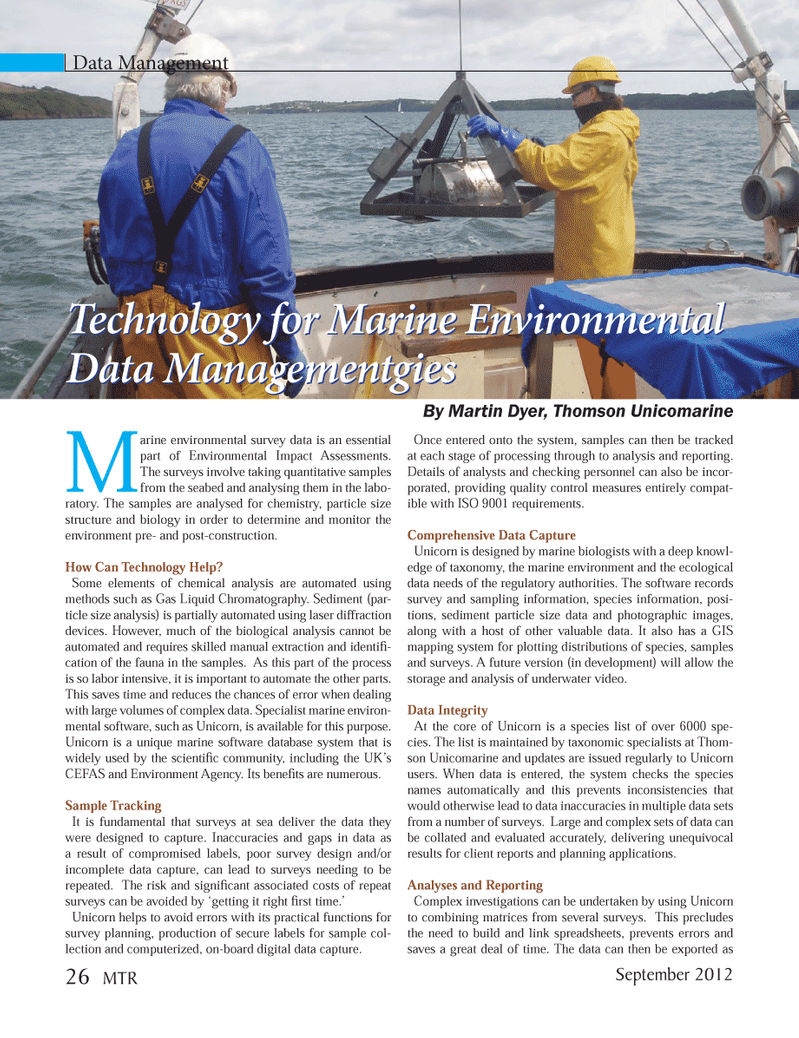
Page 26: of Marine Technology Magazine (September 2012)
Subsea Defense: Protecting Port & Subsea
Read this page in Pdf, Flash or Html5 edition of September 2012 Marine Technology Magazine
Marine environmental survey data is an essential part of Environmental Impact Assessments. The surveys involve taking quantitative samples from the seabed and analysing them in the labo-ratory. The samples are analysed for chemistry, particle size structure and biology in order to determine and monitor the environment pre- and post-construction. How Can Technology Help? Some elements of chemical analysis are automated using methods such as Gas Liquid Chromatography. Sediment (par- ticle size analysis) is partially automated using laser diffraction devices. However, much of the biological analysis cannot be automated and requires skilled manual extraction and identiÞ -cation of the fauna in the samples. As this part of the process is so labor intensive, it is important to automate the other parts. This saves time and reduces the chances of error when dealing with large volumes of complex data. Specialist marine environ- mental software, such as Unicorn, is available for this purpose. Unicorn is a unique marine software database system that is widely used by the scientiÞ c community, including the UKÕs CEFAS and Environment Agency. Its beneÞ ts are numerous. Sample Tracking It is fundamental that surveys at sea deliver the data they were designed to capture. Inaccuracies and gaps in data as a result of compromised labels, poor survey design and/or incomplete data capture, can lead to surveys needing to be repeated. The risk and signiÞ cant associated costs of repeat surveys can be avoided by Ôgetting it right Þ rst time.Õ Unicorn helps to avoid errors with its practical functions for survey planning, production of secure labels for sample col- lection and computerized, on-board digital data capture. Once entered onto the system, samples can then be tracked at each stage of processing through to analysis and reporting. Details of analysts and checking personnel can also be incor- porated, providing quality control measures entirely compat- ible with ISO 9001 requirements.Comprehensive Data Capture Unicorn is designed by marine biologists with a deep knowl- edge of taxonomy, the marine environment and the ecological data needs of the regulatory authorities. The software records survey and sampling information, species information, posi- tions, sediment particle size data and photographic images, along with a host of other valuable data. It also has a GIS mapping system for plotting distributions of species, samples and surveys. A future version (in development) will allow the storage and analysis of underwater video. Data IntegrityAt the core of Unicorn is a species list of over 6000 spe- cies. The list is maintained by taxonomic specialists at Thom- son Unicomarine and updates are issued regularly to Unicorn users. When data is entered, the system checks the species names automatically and this prevents inconsistencies that would otherwise lead to data inaccuracies in multiple data sets from a number of surveys. Large and complex sets of data can be collated and evaluated accurately, delivering unequivocal results for client reports and planning applications.Analyses and ReportingComplex investigations can be undertaken by using Unicorn to combining matrices from several surveys. This precludes the need to build and link spreadsheets, prevents errors and saves a great deal of time. The data can then be exported as Data Management Technology for Marine Environmental Data Managementgies Technology for Marine Environmental Data Managementgies By Martin Dyer, Thomson Unicomarine 26 MTRSeptember 2012MTR #7 (18-33).indd 26MTR #7 (18-33).indd 269/10/2012 9:30:15 AM9/10/2012 9:30:15 AM

 25
25

 27
27
